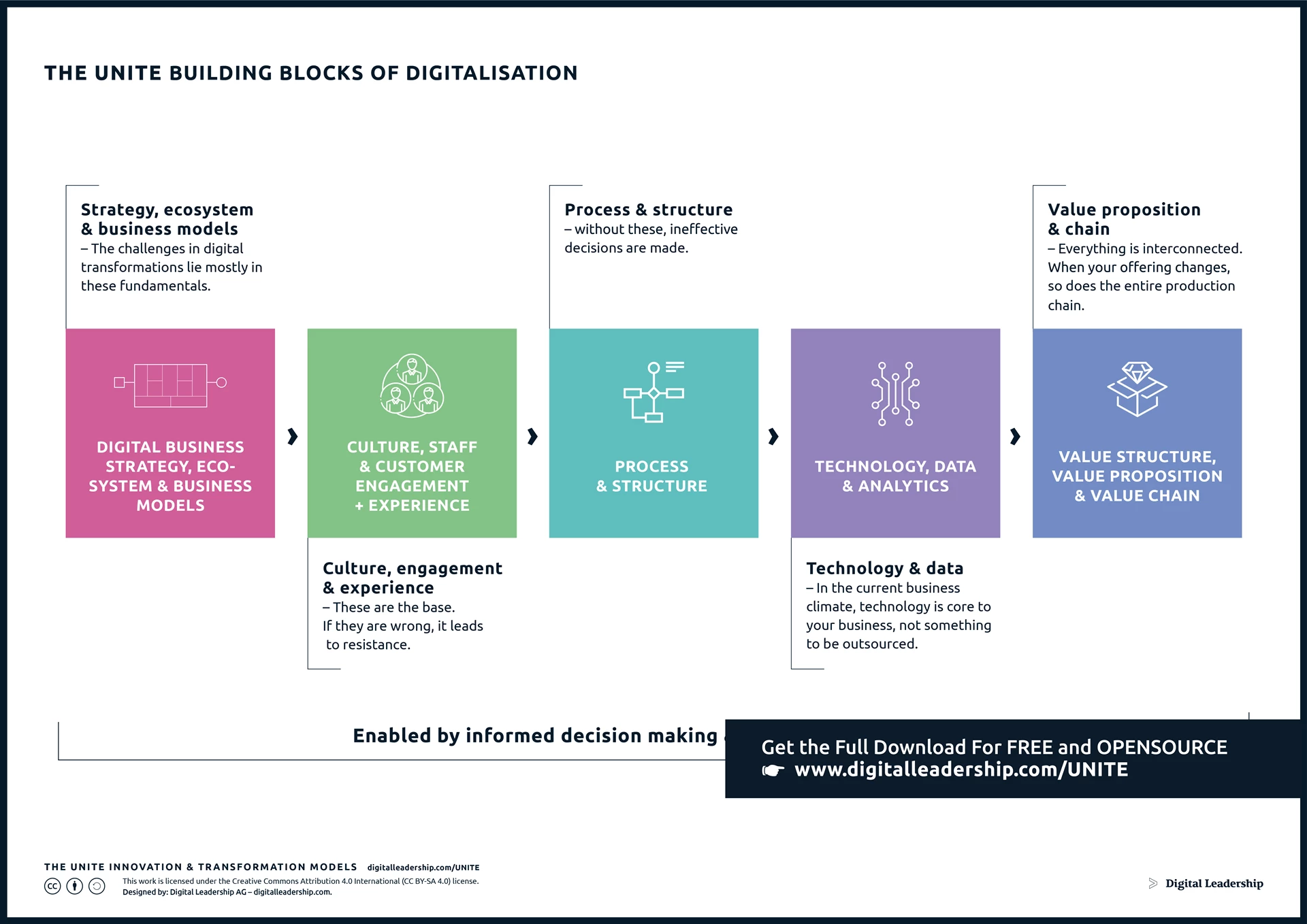Benefits of Digital Transformation in the Era of Economic Development
Published: 11 February, 2023
Transformation

Table of Contents
Digital transformation is a key component of a successful innovation strategy for modern businesses. It involves the integration of digital technologies into all areas of a company, resulting in fundamental changes to how the business operates and delivers value to customers. A well-designed digital transformation strategy can bring about a wide range of benefits, from increased efficiency and productivity to improved customer experiences and satisfaction.
At Digital Leadership, our partners have a wealth of experience in guiding businesses through digital transformation. They work closely with organizations to develop effective strategies that drive innovation and help them stay ahead of the competition. Let us be your partner on your digital transformation journey and help you unlock the full potential of technology for your business.
Our services are tailored to align seamlessly with the benefits of digital transformation. With our specialization in Digital Transformation solutions and Digital transformation consulting, we help businesses worldwide leverage the power of technology to its fullest extent and achieve maximum potential in their digital transformation journey.
What is Digital Transformation?
Digital transformation can be defined as the integration of digital technology into all areas of a business, aimed at creating a more efficient and innovative organization. It involves the use of digital tools, processes, and mindsets to drive business success and achieve new levels of growth. A well-designed digital transformation strategy is an essential component of any innovation strategy.
Across each horizon of growth, digital transformation can take on different forms and focus on different types of innovation. For example:
- Horizon 1 (Improve): Improving a business (model) means making incremental changes in order to execute your current systems and processes more effectively. This is well understood since this is what most people work on every day.
- Horizon 2 (Transform): Transforming an existing business (model) is focused on evolving your existing business in new directions. You seek to change at least one part of your Business Model in a more significant way, i.e., a step-change.
- Horizon 3 (Innovate): Innovating a new Business Model is focused on radical innovation. You venture beyond and explore unknown possibilities through an innovation of the Business Model itself.
In each stage of growth, the focus of digital transformation may shift, but the goal remains the same: to use technology to drive business success and achieve new levels of growth through innovation.
Related: The Three Horizons of Growth Model: A Roadmap to Successful Innovation Strategy

Designed By: Digital Leadership AG
Why Digital Transformation? Digital Transformation Importance
In the current era, digital technologies are driving the Fourth Industrial Revolution, which is characterized by a fusion of digital, physical, and biological systems. This is creating new opportunities for economic growth and development, as well as disrupting traditional business models and industries.
For organizations that want to participate in this digital-driven economic growth, digital transformation is essential. By adopting digital technologies and processes, businesses can improve their competitiveness and take advantage of new opportunities for growth. This can result in increased revenue, improved customer satisfaction, and enhanced operational efficiency.
Additionally, digital transformation can help organizations stay ahead of the curve as new waves of economic development emerge. For example, the rise of Industry 4.0 technologies such as artificial intelligence, the Internet of Things, and blockchain are already transforming the manufacturing sector and creating new opportunities for growth. By embracing digital transformation, organizations can position themselves to take advantage of these new technologies and capitalize on the next wave of economic development.

Designed by: Susanne M.Zaninelli & Stefan F.Dieffenbacher
Digital transformation not only helps organizations participate in digital-driven economic growth, but it also provides numerous benefits that can positively impact the bottom line. Adopting digital technologies and processes leads to improved competitiveness, increased revenue, and enhanced operational efficiency.
In addition, a focus on digital transformation can help organizations stay ahead of the curve and take advantage of new waves of economic development. For example, embracing Industry 4.0 technologies can open up new opportunities for growth and drive innovation.
Benefits of Digital Transformation
The benefits of digital transformation are numerous and can significantly impact an organization’s bottom line. By implementing a digital transformation strategy, businesses can improve their overall efficiency and streamline their operations. This can lead to:
- Increased Efficiency and Productivity
- Better Customer Experiences and Satisfaction
- Increased Agility and Flexibility
- Enhanced Data Management and Analytics
- Improved Security and Privacy
- Lower Costs and Increased Revenue
(1) Increased Efficiency and Productivity:
- Automation of Repetitive Tasks: Automation of repetitive tasks, such as data entry, reduces the time and resources required for these tasks and frees up employees to focus on more strategic tasks. By automating routine tasks, businesses can improve efficiency and productivity, as well as reduce the risk of errors.
- Streamlining of Business Processes: Digital transformation can streamline business processes, such as supply chain management and procurement, by reducing manual steps and improving communication and collaboration between different departments and stakeholders. This results in improved accuracy, speed, and efficiency.
- Improved Collaboration and Communication: Digital technologies and processes can facilitate communication and collaboration across departments and with external partners, improving the flow of information and decision-making. This can lead to increased productivity, faster problem resolution, and improved customer satisfaction.
- Real-time Access to Data and Information: Digital transformation can provide real-time access to data and information, allowing businesses to make informed decisions and respond quickly to changing conditions. This can improve decision-making, enhance customer experiences, and drive revenue growth.
(2) Better Customer Experiences and Satisfaction:
- Personalization and Customization: Digital transformation can provide customers with personalized experiences, tailoring products and services to their specific needs and preferences. This can increase customer satisfaction and engagement, leading to increased revenue and customer loyalty.
- Faster Response Times and Resolution of Customer Issues: Digital technologies and processes can help businesses respond to customer inquiries and resolve issues more quickly, improving customer satisfaction and reducing the risk of losing customers.
- Increased Convenience through Digital Channels: Digital transformation can provide customers with convenient access to products and services through digital channels, such as e-commerce and mobile apps. This can improve customer experiences and increase sales.
- Improved Customer Engagement and Loyalty: Digital transformation can enhance customer engagement through interactive experiences and personalized communication, leading to increased customer loyalty and advocacy.
(3) Increased Agility and Flexibility:
- Faster Adoption of New Technologies and Processes: Digital transformation enables organizations to adopt new technologies and processes more quickly, improving their competitiveness and ability to adapt to changing market conditions.
- Improved Ability to Adapt to Changing Market Conditions: Digital transformation can provide organizations with the agility and flexibility to respond to changing market conditions, such as changes in customer preferences or economic conditions. This can help organizations remain competitive and grow.
- Increased Competitiveness in Global Markets: By embracing digital technologies and processes, organizations can improve their competitiveness in global markets, enabling them to expand into new markets and reach new customers.
- Improved Scalability for Growing Businesses: Digital transformation can provide businesses with the scalability they need to grow and meet the demands of their expanding customer base.
(4) Enhanced Data Management and Analytics:
- Improved Data Collection and Analysis: Digital transformation can improve the collection and analysis of data, allowing businesses to make more informed decisions and enhance their operations.
- Increased Accuracy and Insights from Data: Digital technologies and processes can provide organizations with increased accuracy and insights from data, helping them to make better decisions and drive growth.
- Better Decision-Making through Data-Driven Insights: Digital transformation can provide organizations with data-driven insights, improving their ability to make informed decisions and achieve their goals.
- Improved Data Security and Privacy: Digital transformation can also improve data security and privacy, protecting sensitive information and ensuring compliance with regulations.
(5) Improved Security and Privacy:
- Enhanced Protection of Sensitive Information: By adopting digital technologies and processes, businesses can improve the protection of sensitive information, such as customer data and financial information. This can be achieved through the implementation of advanced security measures, such as encryption and multi-factor authentication.
- Improved Compliance with Regulations: Digital transformation can also help organizations stay compliant with regulations, such as data protection laws. By automating processes and having a clear digital audit trail, organizations can ensure they are meeting regulatory requirements.
- Increased Accountability through Digital Audits and Tracking: Digital transformation can provide organizations with greater visibility and control over their data and processes, making it easier to identify and resolve any security or privacy issues.
- Improved Data Backup and Recovery: Digital transformation can also improve data backup and recovery processes, ensuring that critical information is protected in the event of a disaster or data loss.
Closing Thoughts
In conclusion, digital transformation is a vital component of the success of modern businesses. It involves the integration of digital technologies into all areas of a company, transforming the way it operates and delivers value to customers. Adopting a well-designed digital transformation strategy can bring about numerous benefits, from increased efficiency and productivity to improved customer experiences and satisfaction.
With the help of our partners at Digital Leadership, businesses can embark on their digital transformation journey and unlock the full potential of technology for their success. Whether your focus is on improving, transforming, or innovating your business model, digital transformation is essential for staying ahead of the curve and capitalizing on new waves of economic development.

































 Book How to Create Innovation
Book How to Create Innovation